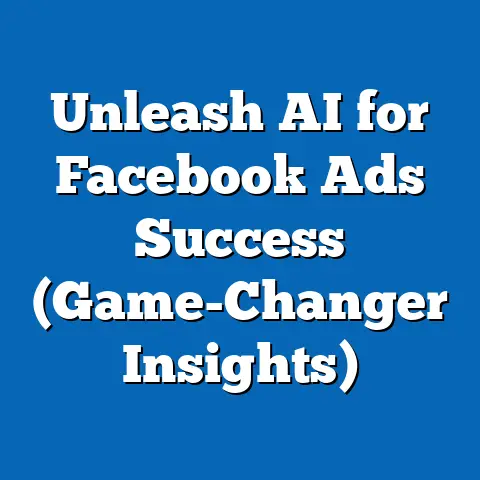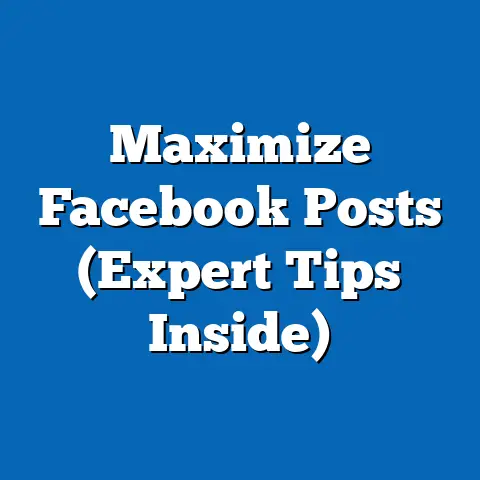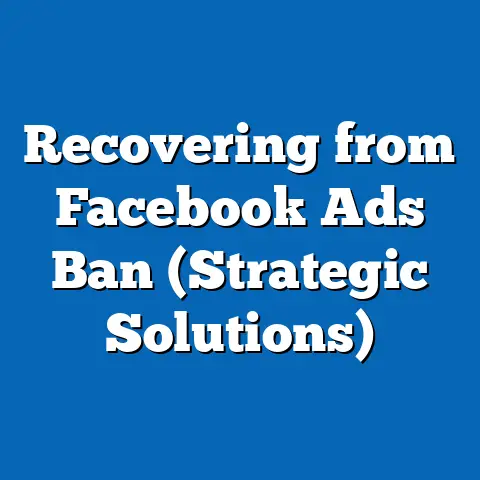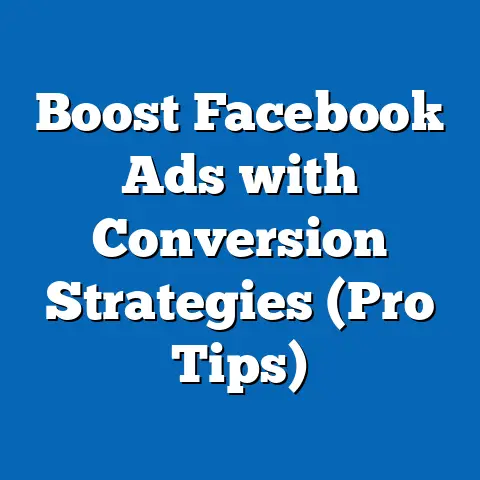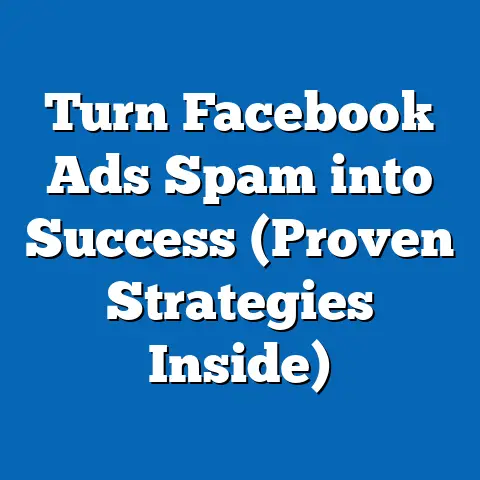Mastering Facebook Ads: Expert Strategies Revealed (Pro Insights)
Let me tell you a story. I once met a small business owner named Sarah who ran a charming little bakery. She was incredibly passionate about her craft, baking the most delicious pastries imaginable. However, her marketing efforts were… well, let’s just say they weren’t as refined as her croissants. She relied mostly on word-of-mouth, which, while valuable, wasn’t enough to truly scale her business. She was frustrated, pouring her heart and soul into her bakery, yet struggling to reach a wider audience. One day, a friend suggested she try Facebook Ads. Sarah was skeptical. “Ads? I’m not a salesperson, I’m a baker!” But she was also desperate. So, she took the plunge.
Initially, her attempts were… let’s just say, less than stellar. Generic images, vague copy, and targeting that was as broad as the Sahara Desert. She was throwing money into the Facebook abyss. Then, she started learning. She devoured articles, watched tutorials, and even invested in a short online course. She learned about the power of targeted audiences, the magic of compelling visuals, and the importance of tracking conversions. Slowly but surely, her campaigns started to improve. She started seeing a real return on her investment. Within a few months, Sarah’s bakery was booming. New customers poured in, drawn by her enticing ads showcasing her delectable creations. Her online orders skyrocketed. Sarah went from feeling overwhelmed and underappreciated to confident and successful, all thanks to mastering Facebook Ads.
Sarah’s story isn’t unique. It’s a testament to the power of Facebook advertising when done right. It’s a journey of learning, adapting, and continuously optimizing. And that’s what I’m here to guide you through. In this article, I’ll share expert strategies and pro insights that will help you master Facebook Ads and transform your marketing efforts, just like Sarah did.
The Evolution of Facebook Advertising
It’s hard to believe that Facebook, now a global advertising behemoth, started as a simple platform for Harvard students to connect. Back in 2004, Mark Zuckerberg likely didn’t envision the advertising powerhouse it would become. But the potential was always there. As Facebook’s user base exploded, it became clear that this was a goldmine for marketers.
The early days of Facebook advertising were… rudimentary, to say the least. Basic text ads with limited targeting options. But as Facebook grew, so did its advertising capabilities. The introduction of the Ads Manager was a game-changer, providing a centralized platform for creating, managing, and analyzing campaigns. Audience Insights offered marketers a glimpse into the demographics, interests, and behaviors of Facebook users, enabling more precise targeting.
The shift towards mobile advertising was another pivotal moment. As smartphones became ubiquitous, Facebook adapted its advertising formats to cater to mobile users, introducing features like mobile app install ads and mobile-optimized video ads.
Today, Facebook advertising is a sophisticated ecosystem, offering a wide range of ad formats, targeting options, and measurement tools. It’s a far cry from the simple text ads of the past. And it continues to evolve, with new features and capabilities being added regularly. Staying on top of these changes is crucial for any marketer who wants to succeed on the platform.
Key Takeaway: Facebook Ads has evolved significantly since its inception, becoming a sophisticated and powerful advertising platform. Understanding this evolution is key to appreciating its current capabilities and future potential.
Understanding the Facebook Ads Ecosystem
Think of the Facebook Ads ecosystem as a complex machine with many interconnected parts. To master it, you need to understand how each part works and how they all fit together. Let’s break it down:
-
Ad Types: Facebook offers a variety of ad types to suit different marketing objectives.
- Image Ads: Simple yet effective, image ads are a great way to showcase your product or service.
- Video Ads: Engaging and attention-grabbing, video ads are perfect for telling your brand story.
- Carousel Ads: Allow you to display multiple images or videos in a single ad, ideal for showcasing a range of products.
- Slideshow Ads: Create a video-like experience using a series of images, a cost-effective alternative to video ads.
- Collection Ads: Primarily for mobile, these ads allow users to browse and purchase products directly from the ad.
-
Ad Placements: Where your ad appears is just as important as the ad itself.
- Facebook News Feed: The most common placement, offering high visibility.
- Instagram: Ideal for visual content and reaching a younger audience.
- Audience Network: Extends your reach beyond Facebook and Instagram to a network of mobile apps and websites.
- Messenger: Allows you to reach users through Messenger ads and sponsored messages.
-
Targeting Options: This is where the magic happens. Facebook’s targeting options are incredibly granular, allowing you to reach specific audiences based on:
- Demographics: Age, gender, location, education, etc.
- Interests: Hobbies, passions, and interests expressed on Facebook.
- Behaviors: Purchase history, device usage, and other online activities.
- Custom Audiences: Reach existing customers by uploading their email addresses or phone numbers.
- Lookalike Audiences: Find new customers who are similar to your existing ones.
-
The Facebook Pixel: This is a crucial piece of code that you install on your website. It tracks user actions, allowing you to:
- Measure Conversions: See which ads are driving sales, leads, and other desired outcomes.
- Retarget Website Visitors: Show ads to people who have visited your website but haven’t yet made a purchase.
- Optimize for Conversions: Tell Facebook to show your ads to people who are most likely to convert.
Ad Types: Facebook offers a variety of ad types to suit different marketing objectives.
- Image Ads: Simple yet effective, image ads are a great way to showcase your product or service.
- Video Ads: Engaging and attention-grabbing, video ads are perfect for telling your brand story.
- Carousel Ads: Allow you to display multiple images or videos in a single ad, ideal for showcasing a range of products.
- Slideshow Ads: Create a video-like experience using a series of images, a cost-effective alternative to video ads.
- Collection Ads: Primarily for mobile, these ads allow users to browse and purchase products directly from the ad.
Ad Placements: Where your ad appears is just as important as the ad itself.
- Facebook News Feed: The most common placement, offering high visibility.
- Instagram: Ideal for visual content and reaching a younger audience.
- Audience Network: Extends your reach beyond Facebook and Instagram to a network of mobile apps and websites.
- Messenger: Allows you to reach users through Messenger ads and sponsored messages.
Targeting Options: This is where the magic happens. Facebook’s targeting options are incredibly granular, allowing you to reach specific audiences based on:
- Demographics: Age, gender, location, education, etc.
- Interests: Hobbies, passions, and interests expressed on Facebook.
- Behaviors: Purchase history, device usage, and other online activities.
- Custom Audiences: Reach existing customers by uploading their email addresses or phone numbers.
- Lookalike Audiences: Find new customers who are similar to your existing ones.
The Facebook Pixel: This is a crucial piece of code that you install on your website. It tracks user actions, allowing you to:
- Measure Conversions: See which ads are driving sales, leads, and other desired outcomes.
- Retarget Website Visitors: Show ads to people who have visited your website but haven’t yet made a purchase.
- Optimize for Conversions: Tell Facebook to show your ads to people who are most likely to convert.
These elements work together to create a powerful advertising ecosystem. By understanding how they interact, you can create highly effective campaigns that reach the right people with the right message at the right time.
Key Takeaway: The Facebook Ads ecosystem is a complex but powerful machine. Understanding its components – ad types, placements, targeting options, and the Facebook Pixel – is crucial for creating successful campaigns.
Audience Targeting: The Heart of Facebook Ads
I truly believe that audience targeting is the single most important aspect of Facebook advertising. You can have the most stunning visuals and the most persuasive copy, but if you’re showing your ads to the wrong people, you’re wasting your money.
Facebook’s targeting options are incredibly granular, allowing you to reach specific audiences based on a wide range of factors. Let’s explore some key strategies:
-
Custom Audiences: This allows you to upload your existing customer list (email addresses or phone numbers) and target them directly on Facebook. This is a great way to re-engage existing customers or offer them exclusive deals.
-
Lookalike Audiences: This is where things get really exciting. Facebook can analyze your existing customer list and find new people who are similar to them. This is a powerful way to expand your reach and find new customers who are likely to be interested in your products or services.
-
Retargeting Strategies: This involves showing ads to people who have already interacted with your business in some way, such as visiting your website or engaging with your Facebook page. Retargeting is incredibly effective because you’re reaching people who are already familiar with your brand.
-
Audience Insights: This tool provides valuable data about your target audience, including their demographics, interests, behaviors, and purchase history. Use this information to refine your targeting and create more relevant ads.
Custom Audiences: This allows you to upload your existing customer list (email addresses or phone numbers) and target them directly on Facebook. This is a great way to re-engage existing customers or offer them exclusive deals.
Lookalike Audiences: This is where things get really exciting. Facebook can analyze your existing customer list and find new people who are similar to them. This is a powerful way to expand your reach and find new customers who are likely to be interested in your products or services.
Retargeting Strategies: This involves showing ads to people who have already interacted with your business in some way, such as visiting your website or engaging with your Facebook page. Retargeting is incredibly effective because you’re reaching people who are already familiar with your brand.
Audience Insights: This tool provides valuable data about your target audience, including their demographics, interests, behaviors, and purchase history. Use this information to refine your targeting and create more relevant ads.
Example: Let’s say you’re selling organic dog food. Using Facebook’s targeting options, you could target people who:
- Are interested in dogs and pet care
- Have purchased pet products online in the past
- Live in a specific geographic area
- Have liked pages related to organic food and healthy living
By combining these targeting options, you can create a highly targeted audience of dog owners who are likely to be interested in your organic dog food.
Key Takeaway: Audience targeting is the heart of Facebook Ads. By leveraging custom audiences, lookalike audiences, retargeting strategies, and Audience Insights, you can reach the right people with the right message and maximize your ROI.
Crafting Compelling Ad Copy and Visuals
Once you’ve nailed your audience targeting, the next step is to create compelling ad copy and visuals that grab attention and drive action. Think of your ad as a tiny billboard competing for attention in a crowded digital landscape. You need to make it stand out.
Here are some guidelines for crafting effective ad copy:
- Write Persuasive Headlines: Your headline is the first thing people will see, so make it count. Use strong verbs, create a sense of urgency, and highlight the benefits of your product or service.
- Highlight the Benefits: Don’t just list features; focus on the benefits. How will your product or service improve the lives of your customers?
- Keep it Concise: People have short attention spans, so get to the point quickly.
- Use a Clear Call to Action: Tell people what you want them to do. “Shop Now,” “Learn More,” “Sign Up Today.”
When it comes to visuals, here are some tips:
- Use High-Quality Images and Videos: Blurry, pixelated images will turn people off. Invest in professional-quality visuals that showcase your product or service in the best possible light.
- Choose Images That Resonate with Your Target Audience: Consider their demographics, interests, and cultural background.
- Use Bright Colors and Eye-Catching Designs: Make your ad stand out from the crowd.
- A/B Test Different Creatives: Experiment with different images, videos, and copy to see what works best.
Example: Let’s say you’re advertising a new line of eco-friendly cleaning products. Here’s an example of effective ad copy and visuals:
- Headline: “Clean Your Home Without Harming the Planet!”
- Body Text: “Introducing our new line of eco-friendly cleaning products, made with plant-based ingredients and sustainable packaging. Safe for your family, safe for the environment. Shop now and get 20% off your first order!”
- Visual: A bright, clean image of a family using the cleaning products in their home.
Key Takeaway: Compelling ad copy and visuals are essential for grabbing attention and driving action. Use persuasive headlines, highlight the benefits, keep it concise, and use high-quality images and videos that resonate with your target audience.
Budgeting and Bidding Strategies
Setting the right budget and bidding strategy is crucial for maximizing your ROI on Facebook Ads. You need to find the sweet spot where you’re spending enough to reach your target audience but not wasting money on ineffective campaigns.
Here are some key considerations:
- Daily vs. Lifetime Budgets: Daily budgets allow you to spend a certain amount each day, while lifetime budgets allow you to spend a set amount over the entire duration of your campaign. Choose the option that best suits your needs and campaign objectives.
- Understanding CPC, CPM, and ROAS: These are key metrics for measuring the performance of your campaigns.
- CPC (Cost Per Click): The amount you pay each time someone clicks on your ad.
- CPM (Cost Per Thousand Impressions): The amount you pay for every 1,000 times your ad is shown.
- ROAS (Return on Ad Spend): The amount of revenue you generate for every dollar you spend on advertising.
- Bidding Strategies: Facebook offers a variety of bidding strategies, including:
- Lowest Cost: Facebook will try to get you the most results for your budget.
- Target Cost: You set a target cost per result, and Facebook will try to achieve that target.
- Manual Bidding: You set your own bids, giving you more control over your spending.
- Optimize Budgets for Maximum ROI: Continuously monitor the performance of your campaigns and adjust your budgets accordingly. If an ad is performing well, increase its budget. If an ad is underperforming, decrease its budget or pause it altogether.
- CPC (Cost Per Click): The amount you pay each time someone clicks on your ad.
- CPM (Cost Per Thousand Impressions): The amount you pay for every 1,000 times your ad is shown.
- ROAS (Return on Ad Spend): The amount of revenue you generate for every dollar you spend on advertising.
- Lowest Cost: Facebook will try to get you the most results for your budget.
- Target Cost: You set a target cost per result, and Facebook will try to achieve that target.
- Manual Bidding: You set your own bids, giving you more control over your spending.
Example: Let’s say you’re running a campaign to generate leads for your business. You set a daily budget of $50 and use the “Lowest Cost” bidding strategy. After a week, you notice that your CPC is $2 and your conversion rate is 5%. This means that you’re paying $2 for each click and that 5% of those clicks are converting into leads. Based on this data, you can adjust your budget and bidding strategy to improve your ROI.
Key Takeaway: Setting the right budget and bidding strategy is crucial for maximizing your ROI on Facebook Ads. Understand key metrics like CPC, CPM, and ROAS, and continuously monitor the performance of your campaigns to optimize your spending.
Analyzing and Optimizing Campaign Performance
Running Facebook Ads is not a “set it and forget it” kind of thing. It requires continuous monitoring, analysis, and optimization. You need to keep a close eye on your campaign performance and make adjustments as needed to improve your results.
Here are some key performance metrics to track:
- Click-Through Rate (CTR): The percentage of people who see your ad and click on it. A high CTR indicates that your ad is relevant and engaging.
- Conversion Rate: The percentage of people who click on your ad and complete a desired action, such as making a purchase or filling out a form. A high conversion rate indicates that your landing page is effective and that your offer is compelling.
- Engagement: The number of likes, comments, and shares your ad receives. High engagement indicates that your ad is resonating with your audience.
- Cost Per Result: The amount you pay for each desired outcome, such as a lead, a sale, or a website visit. A low cost per result indicates that your campaign is efficient.
Here are some strategies for optimizing underperforming ads:
- A/B Test Different Creatives: Experiment with different images, videos, and copy to see what works best.
- Refine Your Targeting: Make sure you’re targeting the right people.
- Improve Your Landing Page: Make sure your landing page is relevant to your ad and that it’s easy for people to complete the desired action.
- Adjust Your Bidding Strategy: Experiment with different bidding strategies to see which one works best for your campaign.
Example: Let’s say you’re running a campaign to promote a new product. You notice that your CTR is low and that your cost per result is high. This indicates that your ad is not resonating with your audience. You decide to A/B test different headlines and images. After a week, you find that a new headline and image combination significantly improves your CTR and reduces your cost per result.
Key Takeaway: Analyzing and optimizing campaign performance is crucial for maximizing your ROI on Facebook Ads. Track key performance metrics, identify underperforming ads, and implement strategies to improve your results.
Case Studies of Successful Facebook Ad Campaigns
To further illustrate the power of Facebook Ads, let’s take a look at a couple of real-world examples:
Case Study 1: A Local Restaurant
A local restaurant wanted to increase its lunchtime traffic. They created a Facebook ad campaign targeting people who lived or worked within a 5-mile radius of the restaurant. The ad featured a mouthwatering image of their signature dish and offered a special lunchtime discount. The campaign resulted in a significant increase in lunchtime traffic and a boost in overall revenue.
Case Study 2: An E-commerce Store
An e-commerce store selling handmade jewelry wanted to expand its reach and increase sales. They created a Facebook ad campaign targeting women aged 25-45 who were interested in fashion and jewelry. The ad featured a carousel of their most popular jewelry pieces and offered free shipping on orders over $50. The campaign resulted in a significant increase in website traffic, sales, and brand awareness.
These case studies demonstrate that Facebook Ads can be an effective tool for businesses of all sizes and industries. By leveraging the platform’s targeting options, ad formats, and measurement tools, you can achieve your marketing goals and grow your business.
Key Takeaway: These case studies highlight the effectiveness of Facebook Ads for businesses of all sizes. By implementing the strategies discussed in this article, you can achieve similar results and grow your business.
Conclusion
Mastering Facebook Ads is a journey, not a destination. It requires continuous learning, experimentation, and optimization. But the rewards are well worth the effort. By leveraging the strategies and insights I’ve shared in this article, you can unlock the full potential of Facebook advertising and transform your marketing efforts.
Remember Sarah, the baker? She started with little knowledge and a lot of skepticism. But through dedication and a willingness to learn, she transformed her business and achieved her dreams. You can do the same.
So, take action. Start implementing these strategies in your own campaigns. Track your results, analyze your data, and continuously optimize your efforts. With a little bit of effort and a lot of dedication, you can master Facebook Ads and achieve your marketing goals. Good luck!

